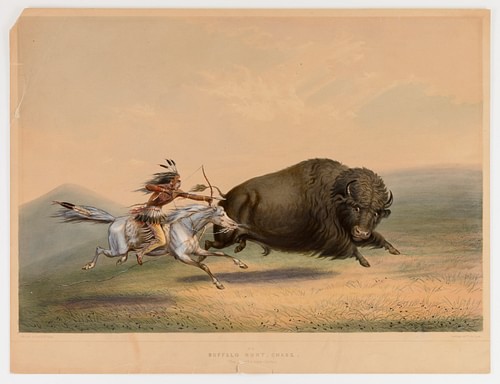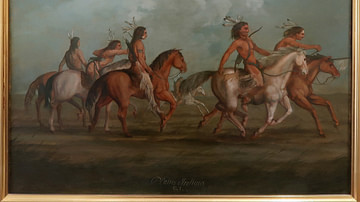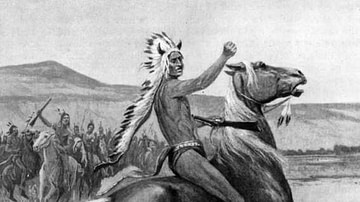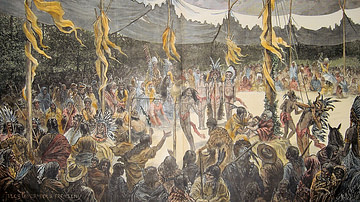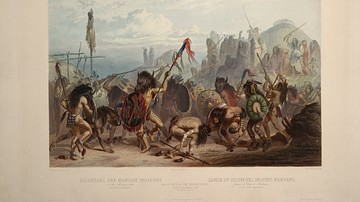Two popular Cheyenne legends are the Origin of the Buffalo and How the Buffalo Hunt Began (also known as The Great Race), both dealing with the importance of the North American bison to the Cheyenne nation. Like others of the Plains Indians culture, the bison were essential to the daily life of the Cheyenne people.
The Cheyenne regarded the bison (commonly referred to as buffalo) as an essential resource for food that also enabled the people to make necessary items. According to scholar Adele Nozedar (among many others), these included tools, clothes, footwear, tipis, bedding, cups, spoons, bowls, and even fly swatters made from the tails (62). The buffalo's bones and sinew were also used by the community's religious authorities – the medicine man and medicine woman – in many different religious rituals, including the invocation of healing spirits in treating the sick or wounded.
The buffalo was also understood by the Cheyenne as a sacred gift from the Creator, as it was by all of the Plains Indians nations, and was respected accordingly. When the animals were hunted and killed, they were honored for their sacrifice in providing the people with what they needed, not only to survive but to live fully in communion with the Creator God. The buffalo was central to many religious rites, including the Sun Dance, and was integral to the lives of the people of the Great Plains.
Between c. 1840-1900, the US government supported and encouraged the whole-scale slaughter of the buffalo as part of their systematic genocidal program of elimination of Native American nations, who were seen as obstacles to civilization in North America. Both the buffalo and the people survived, however, and today the buffalo are regarded by nations like the Cheyenne with the same respect as they were in the past and are honored in the tales still told about them.
Cheyenne & Buffalo
According to the Sioux account given in the tale of White Buffalo Calf Woman, the buffalo was a gift from the Creator, and this was also the belief of the Cheyenne, as clearly illustrated in the Origin of the Buffalo. Nozedar comments:
The Native Americans believed that the buffalo had divine status and describe the coming of the animal in the legend of the White Buffalo Calf Woman. They believed that the gods had created the animal as a special gift to them, and the head and horns were used in rituals and ceremonies. The buffalo, it was believed, had taught the first shaman, or medicine man, his skills in herbalism. (64)
In the Cheyenne legend, Falling Star, the demigod Hotoketana'ohtse ("Falling Star"), among his many other exploits, ensures the survival of his people by capturing the mystical white crow that was warning the buffalo of the approach of the Cheyenne and so allows for successful hunts in the future and the continuation of the people. Falling Star focuses on the many adventures of the hero of the story, the buffalo being only one aspect, but Origin of the Buffalo has them central to the story of how the Cheyenne warriors overcome their fear and enter the mystical cave that will bring them the buffalo.

Origin of the Buffalo
Origin of the Buffalo details how the Cheyenne went in search of a reliable food supply and were given the buffalo through the generosity of a supernatural female figure. As with many Native American tales, the woman in this story serves as a savior figure, providing the male hunters with the means of saving their people from starvation.
The following text, as well as How the Buffalo Hunt Began, are taken from Voices of the Winds: Native American Legends, edited by Margot Edmonds and Ella Clark.
Long ago, a tribe of Cheyenne hunters lived at the head of a rushing stream, which eventually emptied into a large cave.
Because of the great need for a new food supply for his people, the Chief called a council meeting.
"We should explore the large cave," he told his people. "How many brave hunters will offer to go on this venture? Of course, it may be very dangerous, but we have brave hunters." No one responded to the Chief's request.
Finally, one young brave painted himself for hunting and stepped forth, replying to the Chief, "I will go and sacrifice myself for our people."
He arrived at the cave, and to his surprise, First Brave found two other Cheyenne hunters near the opening, where the stream rushed underground.
"Are they here to taunt me," First Brave wondered? "Will they only pretend to jump when I do?"
But the other two braves assured him they would go.
"No, you are mistaken about us. We really do want to enter the cave with you," they said.
First Brave then joined hands with them and together they jumped into the huge opening of the cave. Because of the darkness, it took some time for their eyes to adjust. They then discovered what looked like a door. First Brave knocked, but there was no response. He knocked again, louder.
"What do you want, my brave ones?" asked an old Indian grandmother as she opened her door.
"Grandmother, we are searching for a new food supply for our tribe," First Brave replied. "Our people never seem to have enough food to eat."
"Are you hungry now?" she asked.
"Oh, yes, kind Grandmother, we are very hungry," all three braves answered.
The old grandmother opened her door wide, inviting the young braves to enter.
"Look out there!" she pointed for them to look through her window.
A beautiful wide prairie stretched before their eyes. Great herds of buffalo were grazing contentedly. The young hunters could hardly believe what they saw!
The old grandmother brought each of them a stone pan full of buffalo meat. How good it tasted, as they ate and ate until they were filled. To their surprise, more buffalo meat remained in their stone pans!
"I want you to take your stone pans of buffalo meat back to your people at your camp," said the old grandmother. "Tell them that soon I will send some live buffalo."
"Thank you, thank you, thank you, kind Grandmother," said the three young Cheyenne braves.
When the young hunters returned to their tribe with the gifts of buffalo meat, their people rejoiced over the new, good food. Their entire tribe ate heartily from the old grandmother's three magic pans and were grateful.
When the Cheyenne waked at dawn the next day, herds of buffalo had mysteriously appeared, surrounding their village! They were truly thankful to the old Indian grandmother and to the Sky Spirits for their good fortune.
How the Buffalo Hunt Began
The other popular Cheyenne legend, How the Buffalo Hunt Began, gives the story behind the tradition of the seasonal pursuit of the bison of the Great Plains. This story highlights the reciprocity of the natural world in that, originally, the buffalo fed on humans, but after the Great Race, which the buffalo lost, the roles were reversed.
The tale also serves as an origin story – explaining how things came to be – in that it addresses why the Cheyenne do not eat the buffalo meat from the chest beneath the throat of the animal and how all the birds, beasts, reptiles, and insects came to have their distinguishing colors. If the alternate conclusion at the end that includes the coyote is taken as part of the original tale, the story also gives the reason why the coyote was never eaten by the people, though its skin was used.
The story is reminiscent of animal tales from other Native American nations featuring a race, such as the Pawnee tale, The Girl Who Was the Ring, but that story deals with a relay race of animals trying to keep the ring away from the buffalo, not a race among all creatures for a prize. How the Buffalo Hunt Began is closer in theme and detail to animal stories from other civilizations, notably The Great Race, which gives the origin of the zodiac in ancient China.
In that story, as in this one, a race is decreed with high stakes for the winners and losers in that the first twelve animals to cross the finish line would win a place in the night sky and so live eternally. The story also serves to honor dogs in ancient China by explaining the dog's late place in the zodiac as owing to its friendly nature as, during the race, he had to stop to greet and play with friends. He still finishes the race, however, and is rewarded with a place among the others.
How the humans in the Cheyenne story behave during the race is not given, but they win, not through their own efforts, but due to the friendly nature of the birds who have taken their side. Like the dog in the Chinese tale, the birds recognize what is most important and take their time, pacing themselves, to finally reach their goal. This aspect of the story highlights the value the Cheyenne place on the bonds of friendship and community as the birds win, not for themselves, but for the people.
The buffalo formerly ate man. The magpie and the hawk were on the side of the people, for neither ate the other or the people. These two birds flew away from a council between animals and men. They determined that a race would be held, the winners to eat the losers.
The course was long, around a mountain. The swiftest buffalo was a cow called Neika, "swift head." She believed she would win and entered the race. On the other hand, the people were afraid because of the long distance. They were trying to get medicine to prevent fatigue.
All the birds and animals painted themselves for the race, and since that time they have all been brightly colored. Even the water turtle put red paint around his eyes. The magpie painted himself white on head, shoulders, and tail. At last, all were ready for the race, and stood in a row for the start.
They ran and ran, making some loud noises in place of singing to help themselves to run faster. All small birds, turtles, rabbits, coyotes, wolves, flies, ants, insects, and snakes were soon left far behind. When they approached the mountain, the buffalo-cow was ahead; then came the magpie, hawk, and the people; the rest were strung out along the way. The dust rose so quickly that nothing could be seen.
All around the mountain the buffalo-cow led the race, but the two birds knew they could win, and merely kept up with her until they neared the finish line, which was back to the starting place. Then both birds whooshed by her and won the race for man. As they flew the course, they had seen fallen animals and birds all over the place, who had run themselves to death, turning the ground and rocks red from the blood.
The buffalo then told their young to hide from the people, who were going out to hunt them; and also told them to take some human flesh with them for the last time. The young buffaloes did this, and stuck that meat in front of their chests, beneath the throat. Therefore, the people do not eat that part of the buffalo, saying it is part human flesh.
From that day forward the Cheyenne began to hunt buffalo. Since all the friendly animals and birds were on the people's side, they are not eaten by people, but they do wear and use their beautiful feathers for ornaments.
Another version adds that when coyote, who was on the side of buffalo, finished the race, the magpie who even beat the hawk, said to coyote, "We will not eat you, but only use your skin."
Conclusion
According to Cheyenne tradition, following the Great Race the buffalo and the people maintained a symbiotic relationship: the people were sustained by the buffalo, and buffalos were honored by the people. By the time the Cheyenne encountered the Euro-Americans, they had come to rely heavily on the buffalo for their survival, and so, when the US government stepped up its genocidal policies toward Native Americans in the latter part of the 19th century, they targeted the buffalo for slaughter.
Scholar Roxanne Dunbar-Ortiz cites the description of the relationship between the Plains Indians and the buffalo, as well as the efforts of the white immigrants to destroy them, as given by Old Lady Horse of the Kiowa Nation. The Kiowa, one-time enemies of the Cheyenne, had formed an alliance with them by 1840, around the same time the buffalo began to be slaughtered by white hunters, settlers, and soldiers daily:
Everything the Kiowas had came from the buffalo…Most of all, the buffalo was part of the Kiowa religion. A white buffalo calf must be sacrificed in the Sun Dance. The priests used part of the buffalo to make their prayers when they healed people or when they sang to the powers above. So, when the white men wanted to build railroads, or when they wanted to farm or raise cattle, the buffalo still protected the Kiowas. They tore up the railroad tracks and the gardens. They chased the cattle off the ranges. The buffalo loved their people as much as the Kiowas loved them. There was war between the buffalo and the white men…Then the white men hired hunters to do nothing but kill the buffalo. (143)
From an estimated 60 million buffalos across the Great Plains c. 1800, there were less than 1000 left in 1900, with some estimates as low as 300. Not every Euro-American favored the buffalo's extinction, however, and among the best-known is Fred Dupree (l. 1818-1898), who was influenced by his Lakota Sioux wife, Good Elk Woman (also known as Mary Ann Dupree) to intervene.
Dupree and his sons captured five buffalo calves in 1883 and bred them on his ranch, turning the five into a herd of over 80 by the time of his death. The herd was then purchased and cared for by the rancher James "Scotty" Philip (l. 1858-1911), continued to increase, and became the starter (or among the best-known starter herds) for the approximately 30,000-50,000 bison in North America today. Their number continues to grow, encouraged by the efforts of preservation and conservation groups like the Tanka Fund and other Native American Nations, including the Cheyenne and Arapaho, who still honor the age-old relationship between the buffalo and the people established after the Great Race.
